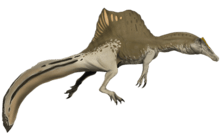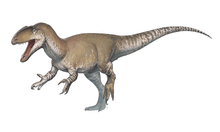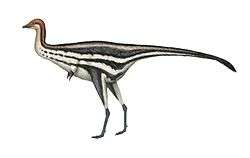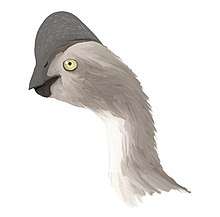Bradycneme
Bradycneme is a genus of theropod dinosaur from the Maastrichtian-age Upper Cretaceous Sânpetru Formation of the Hațeg Basin, Transylvania, Romania. It is known only from a partial right lower leg (specimen BMNH A1588), which its original describers believed came from a giant owl.
| Bradycneme | |
|---|---|
| Scientific classification | |
| Kingdom: | Animalia |
| Phylum: | Chordata |
| Clade: | Dinosauria |
| Clade: | Saurischia |
| Clade: | Theropoda |
| Family: | †Alvarezsauridae |
| Genus: | †Bradycneme Harrison & Walker, 1975 |
| Species: | †B. draculae |
| Binomial name | |
| †Bradycneme draculae Harrison & Walker, 1975 | |
History
Harrison and Walker described two "bradycnemids" from Romania in 1975: B. draculae and Heptasteornis andrewsi. These specimens had initially been assigned to the supposed pelecaniform bird Elopteryx nopcsai. Bradycneme means "ponderous leg", from Ancient Greek bradys (βραδύς) "slow, ponderous" + kneme (κνήμη) "leg", as the holotype, BMNH A1588, a 37.8 millimetres wide distal tibiotarsus found by Maud Eleanora Seeley, would be very stout if the animal had been an owl, indicating a body height of two metres.[1] The specific name draculae is derived from Romanian dracul, "the dragon" and refers to Dracula.[1]
Starting with Pierce Brodkorb,[2] the specimens were soon compared to small theropod dinosaurs. These three genera Bradycneme, Elopteryx and Heptasteornis have been synonymized, split, and reassessed numerous times since then[3] in part because of the fragmentary nature of the remains; there exist three proximal femora and three distal tibiotarsi, which may belong to one, two or three species. Usually, at least one of them is considered to be a troodontid.
In the most recent assessments, Bradycneme and Heptasteornis were found to be the same and most likely basal members of the Tetanurae in one study,[4] but Darren Naish did not follow the synonymy and found Heptasteornis to be an alvarezsaurid, while classifying Bradycneme as an indeterminate maniraptoran.[5] In a 2011 classification, Tom Holtz assigned Bradycneme to the Alvareszauridae along with Heptasteornis.[6]
Footnotes
- Harrison & Walker (1975)
- Brodkorb (1978): pp.223-224
- Paul (1988), Weishampel et al. (1991), Le Loeuff et al. (1992), Csiki & Grigorescu (1998), Naish & Dyke (2004)
- Csiki & Grigorescu (1998)
- Naish & Dyke (2004)
- Holtz, Thomas R. Jr. (2011) Dinosaurs: The Most Complete, Up-to-Date Encyclopedia for Dinosaur Lovers of All Ages, Winter 2010 Appendix.
References
- Brodkorb, Pierce (1978): Catalogue of fossil birds, Part 5 (Passeriformes). Bulletin of the Florida State Museum, Biological Sciences 23(3): 139-228.
- Csiki, G. & Grigorescu, D. (1998): Small theropods from the Late Cretaceous of the Hateg Basin (western Romania) - an unexpected diversity at the top of the food chain. Oryctos 1: 87-104.
- Harrison, Colin James Oliver & Walker, Cyril Alexander (1975): The Bradycnemidae, a new family of owls from the Upper Cretaceous of Romania. Palaeontology 18(3): 563-570. PDF fulltext
- Le Loeuff, J.; Buffetaut, E.; Méchin, P. & Méchin-Salessy, A. (1992): The first record of dromaeosaurid dinosaurs (Saurischia, Theropoda) in the Maastrichtian of southern Europe: palaeobiogeographical implications. Bulletin de la Société géologique de la France 163(3): 337-343.
- Naish, Darren & Dyke, Gareth J. (2004): Heptasteornis was no ornithomimid, troodontid, dromaeosaurid or owl: the first alvarezsaurid (Dinosauria: Theropoda) from Europe. Neues Jahrbuch für Geologie und Paläontologie Monatshefte 7: 385-401.
- Paul, Gregory S. (1988): Predatory Dinosaurs of the World. New York, Simon & Schuster. ISBN 0-671-61946-2
- Stoker, Bram (1897): Dracula.
- Weishampel, D. B.; Grigorescu, D. & Norman, D. B. (1991): The dinosaurs of Transylvania. National Geographic Research and Exploration 7(2): 196-215. PDF fulltext














